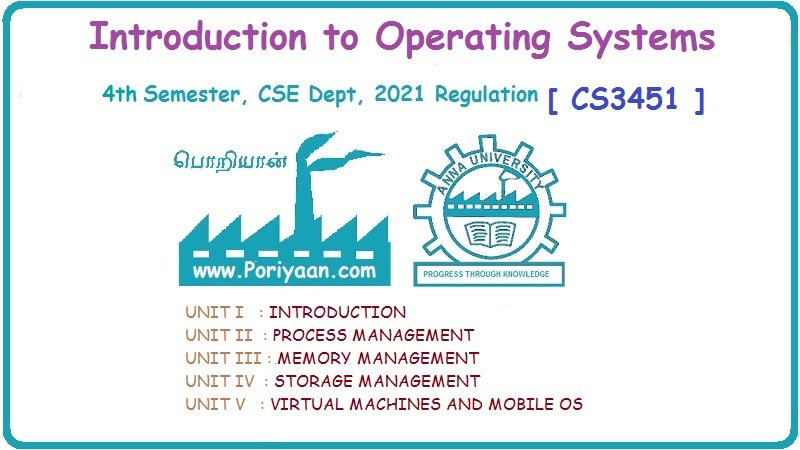Introduction to Operating Systems: Unit IV(a): Storage Management
Disk Scheduling
Storage Management - Introduction to Operating Systems
Disk scheduling algorithms are used to reduce the total seek time of any request. I/O request issues a system call to the operating system. If desired disk drive or controller is idle then the request is served immediately.
Disk Scheduling
AU:
Dec.-17, 18, 19
•
Disk scheduling algorithms are used to reduce the total seek time of any
request. I/O request issues a system call to the operating system. If desired
disk drive or controller is idle then the request is served immediately. If
device is bust then the request for service will be placed in the queue of
pending requests.
•
When one request is completed, the operating system has to choose which pending
request to service next.
• The processor is much faster than the
disk, so it's highly likely that there will be multiple outstanding disk
requests before the disk is ready to handle them. Because disks have
non-uniform access times, re-ordering disk requests can greatly reduce the
latency of disk requests.
•
Multiple requests to disk will arrive while one is being serviced. Disk
scheduling increases the disk's bandwidth.
• To service a request, a disk system
requires that the head be moved to the desired track, then a wait for latency
and finally the transfer of data. In the following section we will examine
several scheduling algorithms.
1. FIFO 2. SSTF 3. SCAN 4. C-SCAN 5. LOOK 6. C-LOOK
First In First Out
• FIFO
is also called first come first served method. Requests are processed in queue
order. Fig. 5.4.1 shows FCFS algorithm. (Fig. 5.4.1 see on next page).
•
FCFS has a fair policy in the sense that once a request has arrived, its place
in the schedule is fixed irrespective of arrival of a higher priority request.
• The requested tracks in the order
received are: 55, 58, 39, 18, 90, 160, 150, 38 and 184. Starting track at 100
and total number of track is 200. FCFS process the entire request in sequential
order:
•
FCFS would begin at track 100, move 45 tracks to 55, and move 3 tracks to 58
and so on. The Y-axis corresponds to the tracks on the disk. The X-axis
corresponds to time or the number of tracks traversed.
• Starting at track 100.
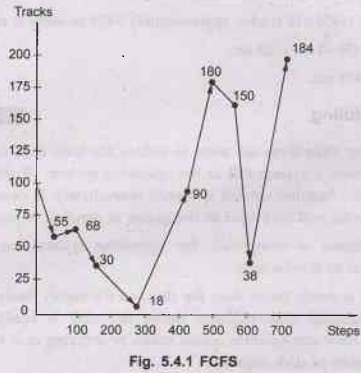
Next accessed track is as below.
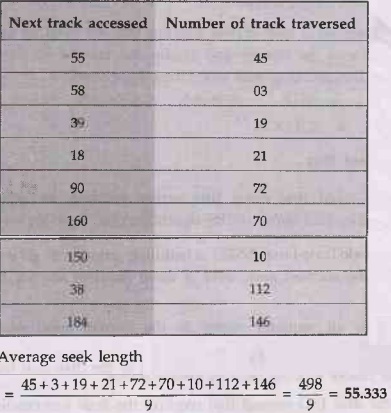
• FCFS is simple to implement. But it
does not provide fast services. It can not take special action to minimize the
overall seek time.
Advantages:
1. Simple and easy to implement.
2.
Suitable for light loads.
Disadvantages:
1.
FCFS does not provide fast services.
2. Do not maximize throughput.
3. May involve lots of unnecessary seek
distance
Shortest Seek Time First
•
SSTF select the next request at the one requiring the minimum seek time from
the current position. Fig. 5.4.2 shows SSTF algorithm.
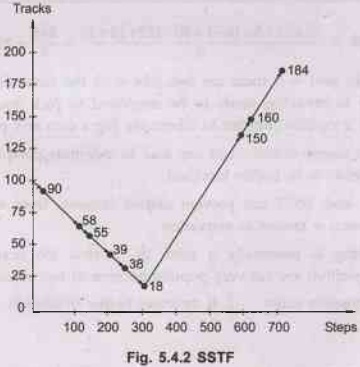
•
In Shortest-Seek-Time-First (SSTF) scheduling priority is given to those
processes which need the shortest seek, even if these requests are not the
first ones in the queue.
•
It means that all requests nearer to the current head positions are serviced
together before moving head to distant tracks.
•
Select the disk I/O request that requires the least movement of the disk arm
from its current position and always choose the minimum seek time.
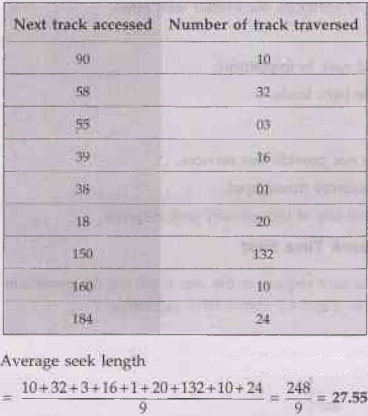
•
The only tricky part is if there are two jobs with the same distance. In this
case, some kind of tie-breaking needs to be employed to pick one. For instance,
you could just use a random number to effectively flip a coin and pick one.
•
SSTF does not ensure fairness and can lead to indefinite postponement because
its seek pattern tends to be highly localized.
•
Under heavy load, SSTF can prevent distant requests from ever being serviced.
This phenomenon is known as starvation.
•
SSTF scheduling is essentially a form of shortest job first scheduling. SSTF
scheduling algorithm are not very popular because of two reasons.
1.
Starvation possibly exists. 2. It increases higher overheads.
Advantages:
1. Throughput is better than FCFS.
2.
SSTF minimize the response time.
3. Less number of head movements.
Disadvantages:
1. One major issue is STARVATION.
2. Localize under heavy load.
SCAN
• SCAN is also
called elevator algorithm.
• The next request scheduled is closest
to current request but in one particular direction. All requests in other
direction are put at the end of the list.
• SCAN services tracks in only one
direction i.e. either increasing or decreasing track number.
• When SCAN reaches the edge of the disk
(or track 0), it reverses direction.
•
If any request comes on its way it will be serviced immediately, while request
arriving just behind the head will have to wait until disk head moves to the
end of the disk, reverses direction and returns before being serviced.
•
SCAN is called elevator because an elevator continues in one direction
servicing requests before reversing direction.
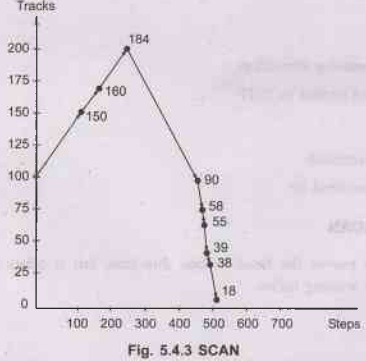
•
Consider the example in which the requested tracks in the order received are :
55, 58, 39, 18, 90, 160, 150, 38, and 184. Starting track at 100 and total
number of track is 200. Head is moving towards increasing track number.
• Current head
position = 100
•
Head is moving towards increasing number of track. Fig. 5.4.3 shows SCAN
algorithm. (Refer Fig. 5.4.3 on previous page.)
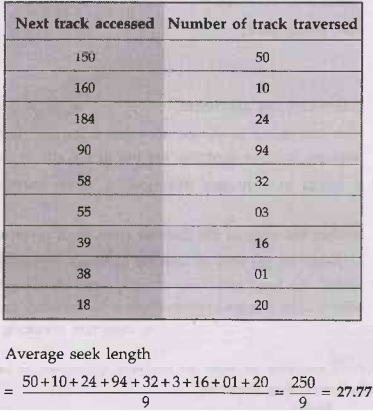
Disadvantages:
1.
Increase overhead
2. Needs directional bit
Circular SCAN
•
C-SCAN also moves the head in one direction, but it offers fairer service with
more uniform waiting times.
• It moves the head from one end of the
disk to the other end, servicing requests along the way. When the head reaches
the other end, it immediately returns to the beginning of the disk, without
servicing any requests on the return trip.
•
C-SCAN treats the cylinders as a circular list that wraps around from the last
cylinder to the first one. It scans in cycles, always increasing or decreasing
order. Fig. 5.4.4 shows C-SCAN. Consider the example in which the requested
tracks in the order received are: 55, 58, 39, 18, 90, 160, 150, 38 and 184.
Starting track at 100 and total number of track is 200. Head is moving towards
increasing track number.
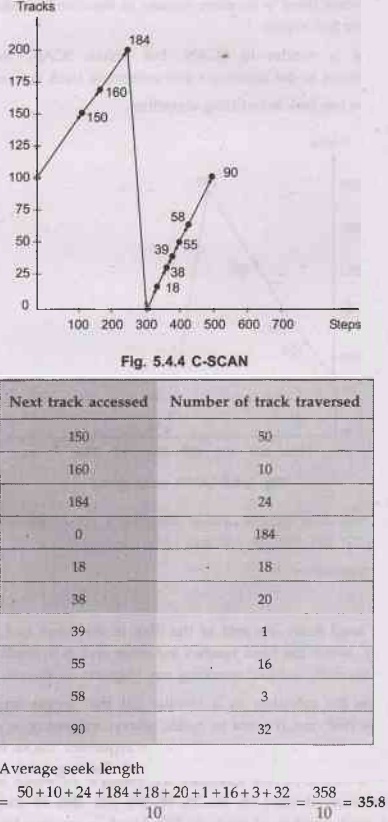
LOOK Scheduling.
•
Start the head moving in one direction. Satisfy the request for the closest
track in that direction when there is no more request in the direction, the
head is traveling, reverse direction and repeat.
• This algorithm is similar to SCAN, but unlike SCAN, the head
does not unnecessarily travel to the innermost and outermost track on each
circuit.
• Fig. 5.4.5 shows the look scheduling
algorithm.
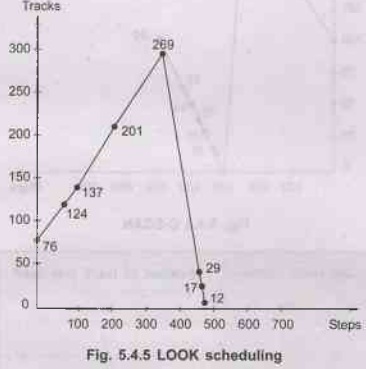
• For example, the disk request queue contains a set of
references for blocks on tracks 76, 124, 17, 269, 201, 29, 137 and 12.
•
Current head position= 76
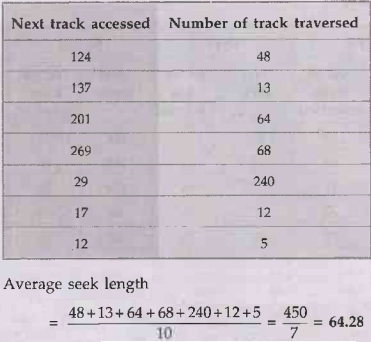
C-LOOK
• C-LOOK is same as C-SCAN except the
head stops after servicing the last requesting the preferred direction, then services the request to the
cylinder nearest the opposite side of the disk.
• Example: Consider the example in which the
requested tracks in the order received are 23, 89, 132, 42, 187. Starting track
at 100 and there are 200 cylinders numbered from 0 - 199.
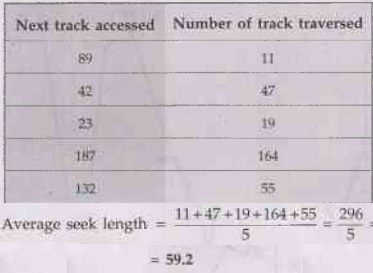
Solved
Examples
Example
5.4.1 The requested tracks, in the order received are: 55, 58, 39, 18, 90,
160, 150, 38, 184. ApplBA the following disk scheduling algorithms. Starting
track at 100.
1) FCFS 2) SSTF
3) SCAN 4) C-SCAN.
Solution
:
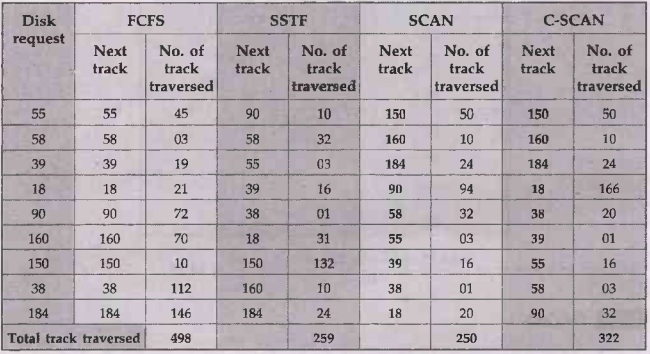
1) FCFS
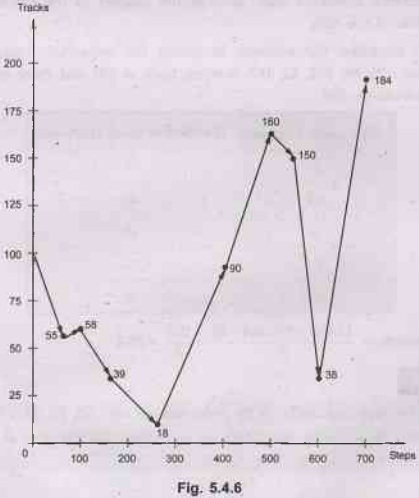
2) SSTF
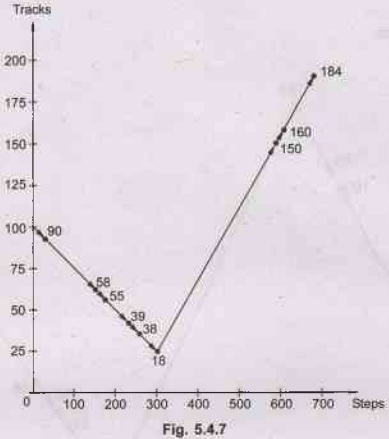
3) SCAN
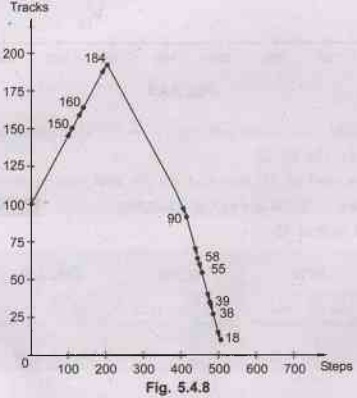
4) C-SCAN

Example 5.4.2 Consider a disk queue with requests for I/O to
blocks on cylinders.
98, 183, 37,
122, 14, 124, 65, 67.
If the disk
head is start at 53, then find out the total head movement with respect to
FCFS, SSTF, SCAN, C-SCAN and LOOK scheduling.
AU May-19, Marks
13
Solution: Disk head is start at 53
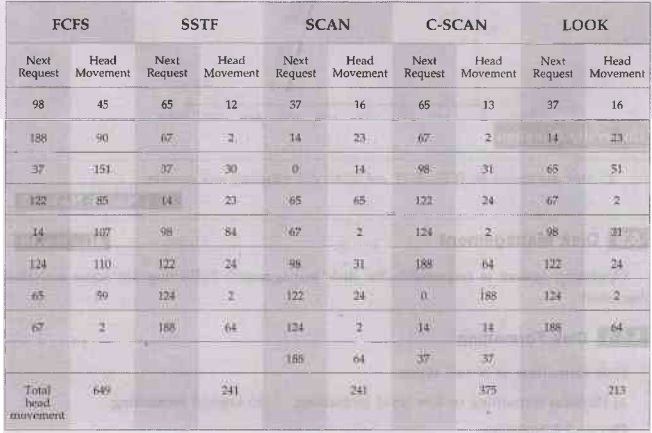
Example
5.4.3 Suppose that a
disk drive has 5000 cylinders, numbered 0 through 4999. The drive is serving a
request at cylinder 143. The queue of pending requests, in FIFO order is 86,
1470, 913, 1774, 948, 1509, 1022, 1750, 130 Starting from the head position
what is the total distance (in cylinders) that the disk arm moves to satisfy
all the pending requests for each of the following disk-scheduling algorithms ?
FCFS, SSTF, SCAN, LOOK, C-SCAN C-LOOK. Explain the pros and cons of all disks
scheduling algorithms.
Solution:
Request
at cylinder = 143
1) FCFS:
143 → 86 →1470 →913 →1774 → 948 →1509 →1022 → 1750 →130. The total seek
distance is 7081.
2) SSTF: 143 → 130 → 86 → 913 → 948 → 1022 →
1470 → 1509 → 1750 →1774. The total seek distance is 1745.
3) SCAN:
143 → 913→ 948 → 1022 → 1470 → 1509 →
1750 →1774→ 4999 → 130 → 86. The total
seek distance is 9769.
4)
LOOK: 143 → 913 → 948 → 1022 → 1470 → 1509 → 1750 → 1774 → 130 → 86.
The total seek distance is 3319.
5)
C-SCAN: 143 → 913 → 948 → 1022 → 1470 → 1509 → 1750 → 1774 → 4999 → 0 → 86 → 130.
The total seek distance is 9985.
6)
C-LOOK: 143 → 913 → 948 → 1022 → 1470 → 1509 → 1750 → 1774 → 86 → 130. The total seek distance is 3363.
University Question
Introduction to Operating Systems: Unit IV(a): Storage Management : Tag: : Storage Management - Introduction to Operating Systems - Disk Scheduling
Related Topics
Related Subjects
Introduction to Operating Systems
CS3451 4th Semester CSE Dept | 2021 Regulation | 4th Semester CSE Dept 2021 Regulation
